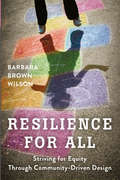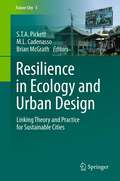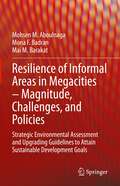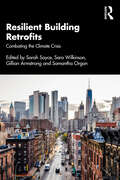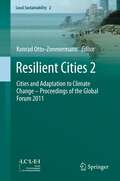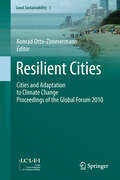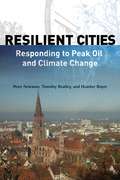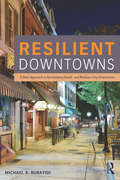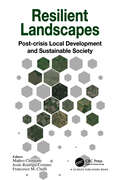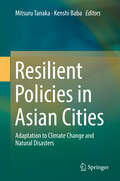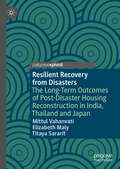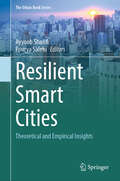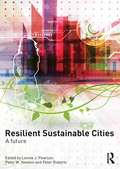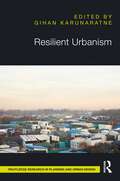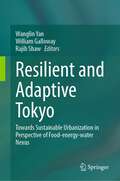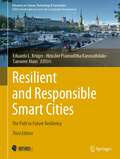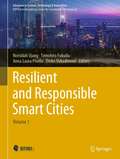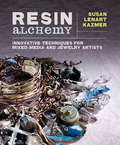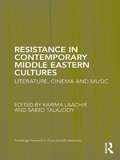- Table View
- List View
Resilience for All: Striving for Equity Through Community-Driven Design
by Barbara Brown WilsonIn the United States, people of color are disproportionally more likely to live in environments with poor air quality, in closeproximity to toxic waste, and in locations more vulnerable to climate change and extreme weather events.In many vulnerable neighborhoods, structural racism and classism prevent residents from having a seat at the table when decisions are made about their community. In an effort to overcome power imbalances and ensure local knowledgeinforms decision-making, a new approach to community engagement is essential.In Resilience for All, Barbara Brown Wilson looks at less conventional, but often more effective methods to makecommunities more resilient. She takes an in-depth look at what equitable, positive change through community-drivendesign looks like in four communities—East Biloxi, Mississippi; the Lower East Side of Manhattan; the Denbyneighborhood in Detroit, Michigan; and the Cully neighborhood in Portland, Oregon. These vulnerable communities haveprevailed in spite of serious urban stressors such as climate change, gentrification, and disinvestment. Wilson looks at how the lessons in the case studies and other examples might more broadly inform future practice. She shows how community-driven design projects in underserved neighborhoods can not only change the built world, but also provide opportunities for residents to build their own capacities.
Resilience in Ecology and Urban Design
by S.T.A. Pickett Brian Mcgrath M. L. CadenassoThe contributors to this volume propose strategies of urgent and vital importance that aim to make today's urban environments more resilient. Resilience, the ability of complex systems to adapt to changing conditions, is a key frontier in ecological research and is especially relevant in creative urban design, as urban areas exemplify complex systems. With something approaching half of the world's population now residing in coastal urban zones, many of which are vulnerable both to floods originating inland and rising sea levels, making urban areas more robust in the face of environmental threats must be a policy ambition of the highest priority. The complexity of urban areas results from their spatial heterogeneity, their intertwined material and energy fluxes, and the integration of social and natural processes. All of these features can be altered by intentional planning and design. The complex, integrated suite of urban structures and processes together affect the adaptive resilience of urban systems, but also presupposes that planners can intervene in positive ways. As examples accumulate of linkage between sustainability and building/landscape design, such as the Shanghai Chemical Industrial Park and Toronto's Lower Don River area, this book unites the ideas, data, and insights of ecologists and related scientists with those of urban designers. It aims to integrate a formerly atomized dialog to help both disciplines promote urban resilience.
Resilience of Informal Areas in Megacities – Magnitude, Challenges, and Policies: Strategic Environmental Assessment and Upgrading Guidelines to Attain Sustainable Development Goals
by Mohsen M. Aboulnaga Mona F. Badran Mai M. BarakatThis book focuses on the socio-economic and sustainability challenges facing megacities in dealing with the dramatic population increases of informal areas and settlements (or slums), especially when coupled with the impacts and risks of climate change. The authors examine informal urban areas globally and in developing countries utilizing strategic environmental assessment (SEA) as a tool to solve the sequence of upgrading steps concerning slums and shanty towns, and also establish essential guidelines for local governments and stakeholders to create a balance and quality of life for slums dwellers, particularly in the age of the COVID-19 pandemic, through applying sustainability indicators that enhance the upgrading process. Coverage includes recent statistics and mapping of informal areas worldwide and assessment of the GIZ and Sir Norman Foster models in terms of energy demands and consequential emission of CO2 and air pollution from slums. Three models of Maspero’s Triangle are also studied and assessed. The book is essential reading for a wide range of researchers, students, policymakers, governments, and professionals as well as a good source for research centers and academicians working in energy, climate change, urban environments, and sustainable urban development.
Resilience of Regionalism in Latin America and the Caribbean: Development and Autonomy (International Political Economy)
by Andrés Rivarola Puntigliano José Briceño-RuizAs regionalisation becomes an increasingly hot topic, the authors explain why regionalism has been most successful in Latin America and analyse current processes and opinions of possible future developments in the region, including the Caribbean, Central America, Brazil, and Mexico.
Resilience vs Pandemics: Innovations in Public Places and Buildings (Urban Sustainability)
by Ali Cheshmehzangi Ayotunde Dawodu Tim Heath Hang Zhao Maycon Sedrez Tian Li“Resilience vs Pandemics: Innovations in Public Places and Buildings” explores innovative solutions for architecture and public places during and after the pandemic. Additionally, the authors contribute to the documentation of architectural and social transformations that have been prompted by previous transmissible diseases, as this knowledge can inform responses to future pandemics. In this volume, the chapters present critical, exploratory, multi- and interdisciplinary, and cutting-edge research approaches; with a particular focus on the effects of COVID-19 and other highly transmissible diseases on the design, use, performance, and perception of the built environment, particularly at the building scale. This volume aims to organize a collection of scientific studies, reviews, analysis, recommendations, and solutions in the fields of urban design, architecture, design, landscape design, etc. The overarching goal is to document new approaches to create and enhance built environment resilience. Chapters shed light on novel methods, tools, processes, regulations, behaviours, and other relevant details contributing to a comprehensive understanding of this crucial issue. The two scales of the built environment under consideration are: (1) Public Places, including research on transformations (death, emergencies, changes), requirements, adaptability, usability, virtual immersion, historical perspectives, interactivity, shifts in use and programs, etc.(2) Buildings, including regulations, shifts in use and program, non-pharmaceutical interventions, human interactions, and human-machine interfaces. The book covers a wide range of studies, including physical and non-physical studies, which may refer to the city infrastructure, green/blue spaces, housing, policy-making, health services, social and economic issues, etc. The findings and results of various global case study examples contribute to the decision-making of governments, organizations, and institutions, as well as inspire scholars and future research for developing resilience in the post-pandemic era.
Resilient Building Retrofits: Combating the Climate Crisis
by Sara Wilkinson Sarah Sayce Gillian Armstrong Samantha OrganThis radical book aims to inject new insight and urgency into the discourse on the retrofitting of commercial and residential buildings in the face of the climate emergency. It is about the why, how and who should take the lead in revolutionising buildings in the face of serious climate and social change. Buildings contribute very significantly to the output of carbon, particularly in developed countries where the stock is old, but it is neither feasible nor desirable to demolish them all and start again! If existing buildings cannot in be replaced in the short-term by new zero carbon stock, retrofitting and adaptation of the existing building stock is critical and urgent. This book explains why and how the improvement of buildings requires a complex, holistic approach that brings all stakeholders together with respect and understanding. Yet to do this against a limited time frame is challenging. The book analyses what must be done, explores how it could be achieved and sets out a manifesto for action by all those engaged: from policy makers, to educationalists, designers, constructors, investors, funders and occupiers. By bringing together authors from across the built environment disciplines, the book stimulates debate within policy, practice and education circles which must lead to action if we are to avoid catastrophe. This is a unique addition to the literature on the sustainability of existing buildings and their retrofitting for the benefit of all.
Resilient Cities 2
by Konrad Otto-ZimmermannAssembling papers originally presented at the Resilient Cities 2011 Congress in Bonn, Germany (June 2011), the second global forum on cities and adaptation to climate change, this volume is the second in a series resulting from this annual event. These cutting-edge papers represent the latest research on the topic and reflect the intensification of the debate on the meaning of and interaction between climate adaptation, risk reduction and broader resilience. Thus, contributors offer more material related to resilience, such as water, energy and food security; green infrastructure; the role of renewables and ecosystem services; vulnerable communities and urban poor; and responsive financing for adaptation and multi-level governance. Overall, the book brings a number of different perspectives to bear on the most pressing issues and controversies surrounding climate change adaptation in cities. These papers will prove invaluable to anyone interested in deepening their understanding of urban resilience and contributing to tackling climate change at the local level.
Resilient Cities, Second Edition: Overcoming Fossil Fuel Dependence
by Timothy Beatley Peter Newman Heather BoyerWhat does it mean to be a resilient city in the age of a changing climate and growing inequity? As urban populations grow, how do we create efficient transportation systems, access to healthy green space, and lower-carbon buildings for all citizens?Peter Newman, Timothy Beatley, and Heather Boyer respond to these questions in the revised and updated edition of Resilient Cities. Since the first edition was published in 2009, interest in resilience has surged, in part due to increasingly frequent and deadly natural disasters, and in part due to the contribution of our cities to climate change. The number of new initiatives and approaches from citizens and all levels of government show the promise as well as the challenges of creating cities that are truly resilient.The authors' hopeful approach to creating cities that are not only resilient, but striving to become regenerative, is now organized around their characteristics of a resilient city. A resilient city is one that uses renewable and distributed energy; has an efficient and regenerative metabolism; offers inclusive and healthy places; fosters biophilic and naturally adaptive systems; is invested in disaster preparedness; and is designed around efficient urban fabrics that allow for sustainable mobility.Resilient Cities, Second Edition reveals how the resilient city characteristics have been achieved in communities around the globe. The authors offer stories, insights, and inspiration for urban planners, policymakers, and professionals interested in creating more sustainable, equitable, and, eventually, regenerative cities. Most importantly, the book is about overcoming fear and generating hope in our cities. Cities will need to claim a different future that helps us regenerate the whole planet–this is the challenge of resilient cities.
Resilient Cities: Cities and Adaptation to Climate Change - Proceedings of the Global Forum 2010
by Konrad Otto-ZimmermannEven with significant reductions of greenhouse gas emissions, a certain degree of climate change will inevitably occur. Adapting to climate change, then, will become a necessary step in reducing the vulnerability of many regions across the globe. This is especially true for urban areas where climate change has been shown to have particularly destabilizing effects. Through the identification and analysis of the most relevant impacts facing urban areas, this book makes clear the need to incorporate climate change concerns into the mainstream of local planning, governance and policy making practices. Adaptation as a workable concept within urban areas cannot be treated in isolation from the many pre-existing challenges facing cities. By offering numerous examples of ongoing adaptation programs and strategies across a wide range of contexts, the authors show the growing potential of cities in the fight against climate change. This book has its origins in a collection of papers originally presented at the Resilient Cities 2010 Congress in Bonn, Germany (May 2010), the first global forum on cities and adaptation to climate change, convened by ICLEI - Local Governments for Sustainability. In this volume, the first in a new series dedicated to this annual event, a range of contributors bring their perspectives to bear on the most pressing issues and controversies surrounding adaptation to climate change within cities. These writings will prove invaluable to anyone interested in understanding and confronting climate change at the local level.
Resilient Cities: Responding to Peak Oil and Climate Change
by Timothy Beatley Peter Newman Heather M. BoyerThe authors of this spirited book don't believe that oblivion is necessarily the destiny of urban areas. Instead, they believe that intelligent planning and visionary leadership can help cities meet the impending crises, and look to existing initiatives in cities around the world. Rather than responding with fear (as a legion of doomsaying prognosticators have done), they choose hope. This is not a book filled with "blue sky" theory (although blue skies will be a welcome result of its recommendations). Rather, it is packed with practical ideas, some of which are already working in cities today. It frankly admits that our cities have problems that will worsen if they are not addressed, but it suggests that these problems are solvable. And the time to begin solving them is now.
Resilient Communities and the Peccioli Charter: Towards the Possibility of an Italian Charter for Resilient Communities
by Maurizio Carta Jose Antonio Lara-Hernandez Maria R. PerbelliniThis book explores urban resilience through significant, original and rigorous academic research, utilising the experiences of town planners, architects and decision makers to create a charter on resilient communities. The second part of the book presents mini-essays discussing the strategic points of the paper, and enabling more casual readers with the ability to access information on urban resilience. The book then explores urban resilience through the work and understanding of the institutions responsible for regulating the professions of urban planner, educators, professionals, and those involved in communication. Providing numerous illustrations and examples, Resilient Communities and the Peccioli Charter will be of interest to researchers, postgraduates, architects, urban designers and planners alike.
Resilient Downtowns: A New Approach to Revitalizing Small- and Medium-City Downtowns
by Michael A. BurayidiResilient Downtowns provides a guide to communities in reviving and redeveloping their core districts into resilient, thriving neighborhoods. While the National Main Street program’s four-point approach of organization, promotion, economic restructuring, and design has been standard practice for cities seeking to rejuvenate their downtowns for decades there is disquiet among downtown managers and civic leaders about the versatility of the program. Resilient Downtowns provides communities with the "en-RICHED" approach, a four-step process for downtown development, which focuses on residential development, immigration strategies, civic functionality, heritage tourism, and good design practice. Examples from fourteen small cities across the US show how this process can revitalize downtowns in any city.
Resilient Landscapes: Post-crisis Local Development and Sustainable Society
by Jesús Rodrigo-Comino Matteo Clemente Francesco M. ChelliIn recent years, resilient districts have become territorial contexts for projects designed to respond to the needs of local communities, through the exploitation of landscape peculiarities to overcome the economic crisis. This volume offers a comprehensive insight on sustainable development of local territories. It recommends the planning of local interventions through the integration of sustainable development with resilience of local systems. The chapters originate from either individual or collective work independently conducted, but at the same time integrated by scholars from different academic backgrounds, among which environmental and agrarian sciences, social and economic disciplines, and urban planning and landscape design are included.
Resilient Policies in Asian Cities: Adaptation to Climate Change and Natural Disasters
by Mitsuru Tanaka Kenshi BabaThis book presents a comprehensive framework and indicators that can be used to assess a city’s degree of resilience. Based on surveys using bottom-up assessment tools, it proposes the concept, framework and indicators of a resilient policy model (including some participatory approaches). It also presents case studies of this and similar tools applied to Japanese and Asian cities, the highlights including information not previously available in English. Today, the term “resilience” is prevalent in the context of sustainable societies. The IPCC AR5 published in 2014 again stressed the impact of climate change on natural disasters, while in March 2015 at the World Conference on Disaster Risk Reduction, the United Nations International Strategy of Disaster Reduction (UNISDR) published the Sendai Framework for Disaster Risk Reduction Action 2015-2030 , which serves as a guideline for local governments. Offering transdisciplinary perspectives from fields such as policy science, urban planning, environmental science, social psychology, management development and geography, this book discusses the lessons learned from Asian case studies, explaining the challenges and the effectiveness of the tools, and offering transdisciplinary insights for policymakers.
Resilient Recovery from Disasters: The Long-Term Outcomes of Post-Disaster Housing Reconstruction in India, Thailand and Japan
by Elizabeth Maly Mittul Vahanvati Titaya SararitThis book is a call to action for housing recovery policymakers and practitioners to leverage foresight and planning capacities to achieve long-term resilience. For human societies to thrive in a rapidly changing climate and uncertain future, it is essential to learn about factors that can catalyse systemic change through disaster recovery processes. This book identifies key factors in housing recovery that meets housing rights of the most vulnerable, as well as help leapfrog to resilience strengthening of housing, its residents and institutions. To capture diverse experiences of stakeholders in various economies, socio-cultural, technical and political contexts, the authors draw from six cases of post-disaster housing reconstruction and rehabilitation projects from larger recovery programs, from three Asian countries – India, Thailand and Japan. This book identifies both unique and common findings. It is an essential resource for disaster recovery and housing practitioners, policymakers, students and researchers.
Resilient Smart Cities: Theoretical and Empirical Insights (The Urban Book Series)
by Ayyoob Sharifi Pourya SalehiThis book provides a thorough guide to building resilient cities, through the use of smart solutions enabled by information and communication technologies. It introduces innovative approaches for integrating smart solutions into urban resilience planning and offers numerous global case studies to illustrate the benefits of the theories discussed. Against a background of increased natural disasters, pandemics, and climate change, this book answers research questions such as: • Do smart city projects contribute to urban climate resilience?• What are the indicators of smart city resilience?• What procedures should be taken to improve efficacy of smart city solutions?• What are the opportunities and challenges for promoting smart city resilience and for integrating resilience thinking into smart city planning? Including contributions from international experts, explanatory illustrations, and data-driven tables, this book is of interest to researchers, policymakers, and graduate students focused on developing more sustainable, smart, and resilient cities.
Resilient Sustainable Cities: A Future
by Peter Roberts Leonie J. Pearson Peter W. NewtonUrbanization is occurring at an unprecedented rate; by 2050 three quarters of the world’s people will live in urban environments. The cars we drive, products we consume, houses we live in and technology we use will all determine how sustainable our cities will be. Bridging the increasing divide between cross-disciplinary academic insights and the latest practical innovations, Resilient Sustainable Cities provides an integrated approach for long term future planning within the context of the city as a whole system. In the next 30 years cities will face their biggest challenges yet, as a result of long term, or ‘slow burn’ issues: population growth will stretch to the breaking point urban infrastructure and service capacity; resource scarcity, such as peak oil; potable water and food security, will dramatically change what we consume and how; environmental pressures will change how we live and where and; shifting demographic preferences will exacerbate urban pressures. Cities can’t keep doing what they’ve always done and cope – we need to change current urban development to achieve resilient, sustainable cities. Resilient Sustainable Cities provides practical and conceptual insights for practitioners, researchers and students on how to deliver cities which are resilient to ‘slow burn’ issues and achieve sustainability. The book is organized around three overarching themes: pathways to the future innovation to deliver the future leadership and governance issues The book includes a variety of perspectives conveyed through international case studies and examples of cities that have transformed for a sustainable future, exploring their successes and failures to ensure that readers are left with ideas on how to turn their city into a resilient sustainable city for the future.
Resilient Urban Environments: Planning for Livable Cities (Cities and Nature)
by Runming YaoThis book aims to provide evidence of the impact of climate change and urbanization on cities’ urban environments thus on human health and wellbeing; and principles and methods for the improvement of the resilience of a city to extreme weather and long-term climatic changes through case studies. The book will have three themes of 1) Understanding the adverse environmental impact on human health and wellbeing; 2) analysis of adaptation and mitigation measures through modeling technologies; 3) providing best practice examples of the implementation of the proposed measures. The book will present the liveable cities including factors affecting liveability; ecological and biophilic city; economic values; health and well-being and opportunities for people. Physical and social health will be an important issue in the context of resilient cities. The widespread concerns will be addressed including physical and mental health; wellbeing in terms of building use;building surroundings and Biophilia; location in the context of sustainability and work-life balance; and spatial scale and community.
Resilient Urbanism (Routledge Research in Planning and Urban Design)
by Gihan KarunaratneAs urban populations grow unprecedentedly, cities worldwide face pressures from rapid expansion, climate change, and social inequalities. Resilient Urbanism critically examines how cities, towns, and informal settlements adapt to these multifaceted challenges, exploring urban resilience in the 21st century.This volume investigates resilience across a variety of urban contexts, from megacities in the Global South to suburban and coastal regions, through interdisciplinary essays. The contributors examine how urban communities confront crises, navigate urbanization, adapt to climate change, and respond to socioeconomic transformations using innovative and, at times, unconventional strategies. Case studies highlight the lived experiences of urban dwellers, from informal settlements in Maputo, Rio de Janeiro, and Hanoi to the challenges of achieving energy efficiency in Buenos Aires.By interrogating dominant discourses on urban resilience, Resilient Urbanism offers a reimagined perspective on how cities and their inhabitants address uncertainty and change. It emphasizes the everyday practices of urban residents and explores the sociopolitical dynamics of urbanization, presenting resilience not merely as a theoretical framework but as a lived, evolving process. This work sheds light on how cities withstand crises and actively reshape themselves in response to these disruptions.This volume is an essential resource for scholars, urban planners, policymakers, and professionals concerned with the future of cities. It underscores that urban resilience is not just a theoretical concept but a vital imperative for navigating the complexities of a rapidly changing global landscape.
Resilient and Adaptive Tokyo: Towards Sustainable Urbanization in Perspective of Food-energy-water Nexus
by Rajib Shaw Wanglin Yan William GallowayOur cities, and the systems that support them, have not been designed to address the FWE nexus. There exist gaps in awareness of the role and impacts of climate change. Improving communication among stakeholders with the support of scientific evidence is the key to narrowing the gaps. This book approached this issue with a multidisciplinary and transdisciplinary moveable nexus approach through the lens of FEW nexus under the project of the Sustainable Urbanization Global Initiative of Belmont Forum. It presents a collection of evidence/science-based planning decisions and participatory practices by using Tokyo as the focal area. It visualizes the stock and flow of the Food-Water-Energy (FEW) supporting the world’s largest metropolitan area, explores how the actors have worked together to secure the resilience and sustainability of resources, and demonstrates the potential of resources in making the city adaptive to climatic and social changes. It is designed for researchers in urbanization, nexus research, urban design research, environment, disaster risk reduction, and climate change studies, and can be used as a textbook for university courses. It is also a useful tool for practitioners and policymakers in applying collective knowledge to policy and decision-making.
Resilient and Responsible Smart Cities (Advances in Science, Technology & Innovation)
by Simon Elias Bibri Hugo Rodrigues Tomohiro FukudaThis book gathers current research studies which explore new technologies in architecture and urban practices which ensure the efficient management of cities’ infrastructures and provide new solutions to the complex complications that may result in the tackling of challenges of population density, traffic planning, and city planning at the neighborhood scale or rather the scale of buildings and everyday life. It offers a path towards city resilience and sustainable infrastructure with the aim of meeting the demands of mega-cities. The primary audience of this book will be academics and professionals from the fields of architecture, urban planning, civil engineering, computer sciences, and mathematics. The book will aid them in their contributions to the implementation of sustainable development goals.
Resilient and Responsible Smart Cities: The Path to Future Resiliency (Advances in Science, Technology & Innovation)
by Eduardo L. Krüger Tanweer Alam Hirushie Pramuditha KarunathilakeThis book is a compilation of diverse, yet homogenic, research papers that discuss current advances in Earth Observation and Geospatial Information Technologies to tackle new horizons concerning the digitization and information management in smart cities’ infrastructures. The book also tackles the challenges faced by urban planners by the new mega-cities and proposes a series of solutions to resolve complex urban issues. It suggests enhancing the integration of disciplines, thus, bringing together architects, urban planners, civil engineers, landscape designers and computer scientists to address the problems that our cities are facing. This book is a culmination of selected research papers from IEREK’s fourth edition of the International Conference on Future Smart Cities (FSC) and the fourth edition of the International Conference on Resilient and Responsible Architecture and Urbanism (RRAU) held online in collaboration with the XMUM, Selangor, Malaysia (2021).
Resilient and Responsible Smart Cities: Volume 1 (Advances in Science, Technology & Innovation)
by Norsidah Ujang Tomohiro Fukuda Anna Laura Pisello Dinko VukadinovićThis book focuses on the ways in which resiliency can foster the transformation of cities. There is a growing need for our cities to be transformed into “smart” cities; in this regard, tremendous efforts are called for in order to face the environmental challenges that play a major role in the creation or transformation of cities and environments. This book covers a broad range of applications and approaches that are “smart” and “resilient,” which, when combined, offer much more flexibility concerning the future of our cities. Consequently, this simple combination, which is producing sweeping changes around the globe, has attracted considerable attention from scholars and decision-makers alike.
Resin Alchemy: Innovative Techniques for Mixed-Media and Jewelry Artists
by Susan Lenart KazmerDiscover one of the hottest trends in mixed media--resin! Join mixed-media and jewelry artist Susan Lenart Kazmer as she opens new frontiers in her application of resin techniques.Resin Alchemy offers detailed step-by-step technique tutorials on using resin, from the basics of mixing and pouring to using bezels and key metalworking techniques that expand design options. She explores creating artistic effects with: • Color • Found objects • Texture • Casting • Collage • And, more! It doesn't stop there! Learn how to incorporate stories, words, meaningful images, and more in the layers of your resin jewelry. Susan shares her wealth of tips for collecting great found objects and for layering and encasing storiesâ€"in short, how to bring both great technique and great imagination to bear on jewelry making. Throughout the book, you'll enjoy easy step-by-step projects and finished pieces.
Resistance in Contemporary Middle Eastern Cultures: Literature, Cinema and Music (Routledge Research in Postcolonial Literatures)
by Karima Laachir Saeed TalajooyThis study highlights the connections between power, cultural products, resistance, and the artistic strategies through which that resistance is voiced in the Middle East. Exploring cultural displays of dissent in the form of literary works, films, and music, the collection uses the concept of 'cultural resistance' to describe the way culture and cultural creations are used to resist or even change the dominant political, social, economic, and cultural discourses and structures either consciously or unconsciously. The contributors do not claim that these cultural products constitute organized resistance movements, but rather that they reflect instances of defiance that stem from their peculiar contexts. If culture can be used to consolidate and perpetuate power relations in societies, it can also be used as the site of resistance to oppression in its various forms: gender, class, ethnicity, and sexuality, subverting existing dominant social and political hegemonies in the Middle East.
